Best Fire Extinguisher IN 2024
Fires could put you in a stressful situation wherein every second counts to prevent further damage of your property or even save you and your loved ones from harm.
Best Overall
Best Portable
Best Kitchen Use
Best Multipurpose
Best Car Fire
Brio House is an independent review site. We may earn money when you click links inside our site.
There’s nothing good about fires. Think about what it would be like to lose everything in your life in a single moment. A fire might come so quickly that you’ll start to freak out, and you won’t know which tasks to focus on first.
It’s much worse if you never imagined that it could happen to you. This is why it’s important to have one of the best fire extinguishers on hand. As the saying goes, “it’s better safe than sorry”, right?
This object may seem like a minor detail. But, having a fire extinguisher is a part of a good safety plan. It might save you and your family’s life down the road.
As with any purchase, you need to find the best one for your needs. After our comprehensive research on fire extinguisher brands and discussions among experts in the fire-safety industry, we came up with the list of the best fire extinguisher that will help you in the case of a fire. Let’s get started.

What is the best type of fire extinguisher?
There is no one-size-fits-all fire extinguisher. The best fire extinguisher will always depend on you, your location, and your conditions.
What’s The Best Fire Extinguisher in 2024?
- First Alert PRO5 : Best Overall
- First Alert EZ Fire Spray : Best Portable
- Amerex B260 : Best Kitchen Use
- Kidde FA110 : Best Multipurpose
- First Alert Car Fire Extinguisher: Best Car Fire Extinguisher
- AFO Fire Ball Fire Extinguisher : Best Automatic and Compact
- First Alert Standard Home Fire Extinguisher : Best Affordable

Reviews: The Best Fire Extinguisher in 2024
Let’s take a look at the best fire extinguishers on the market that offer excellent protection for your property.
1. First Alert PRO5
Best Standard, Heavy Duty Fire Extinguisher
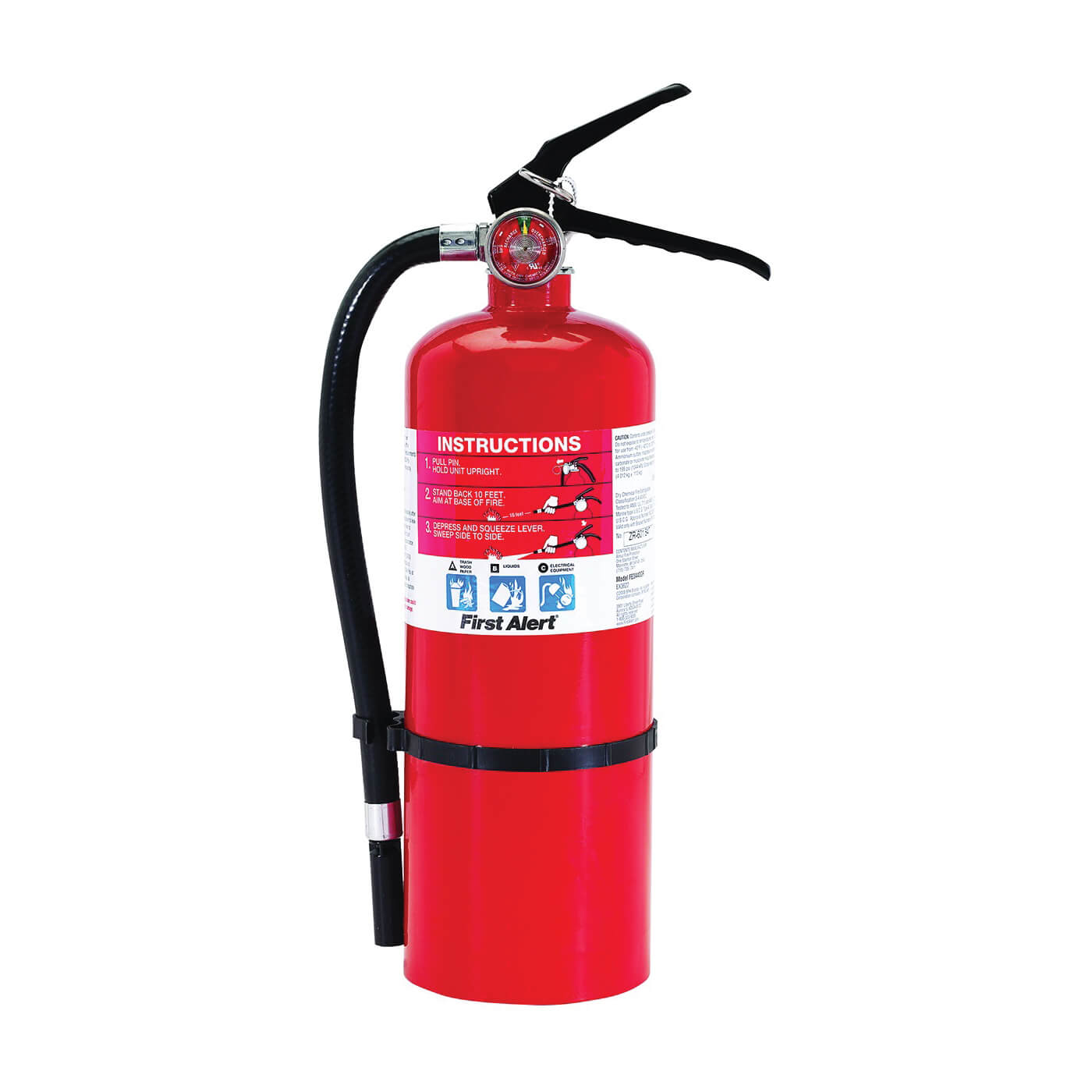
First Alert PRO5
Our Rating:

4.5
The First Alert PRO5 is a great choice for a standard, overall, no-fuss fire extinguisher. It can put out flames caused by paper, wood, flammable substances, and electricity-causing fires. The PRO5’s metal head is built to withstand the most rigorous usage.
Additionally, while in use, the fire extinguisher is rechargeable by a licensed expert to ensure long-term effectiveness. The First Alert PRO5 also comes with a heavy-duty mounting kit and straps to keep it stable.
It is certified by the Underwriters Laboratories (UL), a leading global safety-testing organization. Additionally, it only weighs 10 pounds despite exceeding the size recommendations of the National Fire Protection Association (NFPA). This fire extinguisher could weigh a lot for the physically unfit. But, on the brighter side, it’s easy to use and comes with a manual.
PROS
CONS
2. First Alert EZ Fire Spray, Extinguishing Aerosol Spray
Best Small and Portable Fire Extinguisher
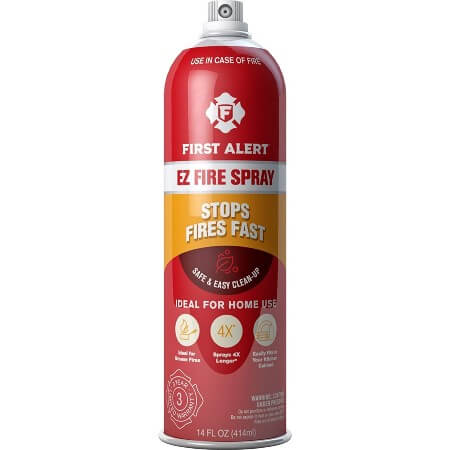
First Alert EZ Fire Spray
Our Rating:

4.8
Not all fire extinguishers are heavy and bulk. This one from First Alert is small and compact. It’s perfect for very minor fires and travel purposes. This way, you can be prepared any time and anywhere. The aerosol spray tip and lightweight design make it so easy to use at home, and on the road. This fire extinguisher’s compounds are also biodegradable. All you need is a wet towel to clean it up.
Of course, this should not be compared to conventional fire extinguishers. The Extinguishing Aerosol Spray features portability and convenience, so don’t try to use it for big fires. You can have this with you in case of minor emergencies, like in the kitchen.
PROS
CONS
3. Amerex B260
Best Kitchen Use Fire Extinguisher
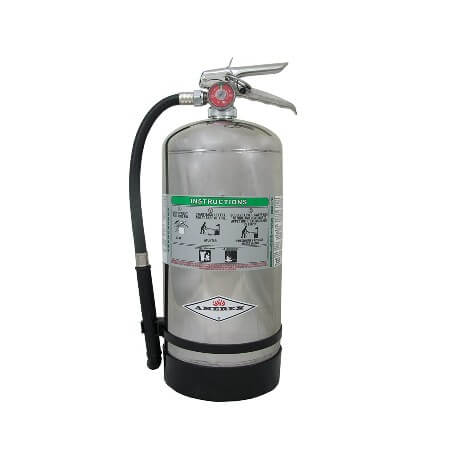
Amerex B260
Our Rating:

4.7
Kitchens are one of the top spots to start fires in a home. If you cook a lot (or own a small food business), then you should have a good kitchen fire extinguisher on hand. One that could stand kitchen and culinary environments.
When it comes to hand-portable fire extinguishers for restaurants, this wet extinguisher is the finest you can get. Each model uses a specially formulated potassium acetate-based solution and has been evaluated and certified by the UL for restaurant risks. Hand-held fire extinguishers with a stronger fire-fighting capability and cooling impact are needed to tackle these extremely hot and challenging flames.
Available in two capacities, 6 liters and 2 and a half gallons, with stainless-steel canisters and a simple-to-use hose and spray distribution tip.
It also does not spray out chemical residue after use. Therefore, no cleanup is needed.
Class A flames may be suppressed with this 22-pound extinguisher. But, Class B or Class C flames (solvents, petrol, etc.) should not be tackled with it.
PROS
CONS
4. Kidde FA110
Best Multipurpose Fire Extinguisher
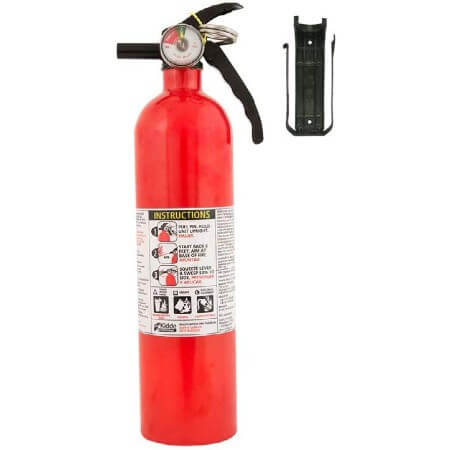
Kidde FA110
Our Rating:

4.7
It’s always best to know how, when, and where you need your extinguisher. But, what if you just need a standard one in case of emergency? Then the Kidde FA110 is for you. It’s renowned to be incredibly multipurpose. You can place it anywhere from the home to the office.
In fact, The NFPA (National Fire Protection Association) recommends the Kidde FA110 Multi-Purpose Fire Extinguisher. This product has also been evaluated by UL (Underwriters Laboratories) and is rated 1-A:10-B:C. The extinguisher is furnished with a convenient pressure gauge that lets you know if it’s charged. It has a nylon grip that is impact-resistant and highly durable, and a lightweight canister.
This Kidde extinguisher is engineered to provide an additional layer of fire safety for your house. Moreover, the label on the Kidde FA110 fire extinguisher clearly explains what you need to do to stop the fire.
PROS
CONS
5. First Alert Car Fire Extinguisher
Best Car Fire Extinguisher
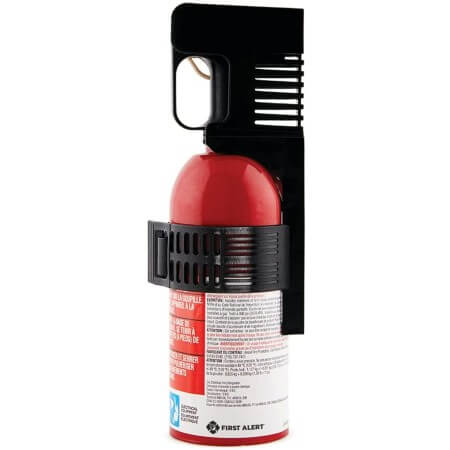
First Alert Car Fire Extinguisher
Our Rating:

4.7
This one is also portable like the First Alert Aerosol Spray. However, it’s much bigger and made for car use. The First Alert Car Fire extinguisher can sit right back in your trunk. In case of an emergency, you can pull it right out to use. It’s always nice knowing you have an extra layer of protection when you travel.
With its 5 B-C ratings, the First Alert FIAFESA5 Auto Fire Extinguisher is capable of extinguishing minor automobile fires such as those caused by gas oil, as well as electrical fires. Keep in mind, however, that this was not suited for fire caused by rubbish, wood, or papers.
Small enough to fit in a trunk, certain bigger glove boxes, or even beneath seats, this First Alert is less than 11 inches tall and weighs less than a pound.
Owners who’ve used it have stated that it swiftly and easily puts out tiny car fires. In addition to the built-in pressure gauge, it also has a special attachment designed to keep it in place while driving.
The First Alert fire extinguisher, like many other motor or car extinguishers, is not refillable. But, it comes with long warranty coverage.
PROS
CONS
6. AFO Fire Ball Fire Extinguisher
Best Automatic and Compact Fire Extinguisher
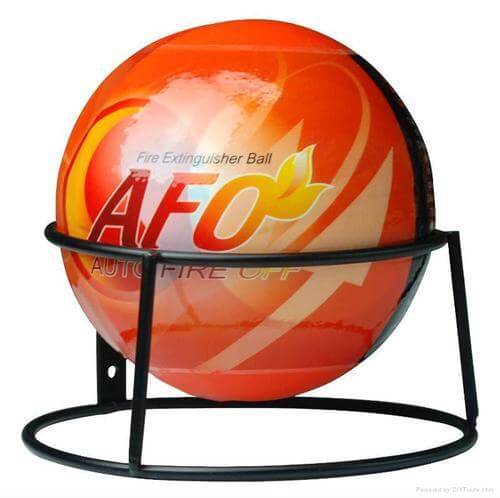
AFO Fire Ball Fire Extinguisher
Our Rating:

4.5
As you can tell by its design, this isn’t your average fire extinguisher. It doesn’t come with a long canister or spray. Instead, all its fire suppressing agents are packed in a compact and lightweight ball that’s less than 3 pounds.
Automatic fire extinguishers are those that can be placed in high-risk locations and immediately suppress a fire without the need for human intervention. An AFO fireball may be used to quickly put out an automobile fire beneath the hood, for instance. They should be placed in an area where a fire can potentially start, such as near your battery charging station, your garage’s fuel tank, or in a circuit board.
The AFO Ball Fire Extinguisher is only certified for Class A, B, or C fires.
The elderly and children can use it when needed. No maintenance is required until its lifespan of 5 years. When the fire begins, simply roll or throw the extinguisher ball into the fire. When exposed to flames, its activation strip activates within 3-10 seconds. Once activated, the fire extinguisher ball emits a loud sound (90-120dBA) and disperses a non-toxic, environmentally friendly chemical that can stop the fire from spreading fast in an area from 86 to 107 square feet.
PROS
CONS
7. First Alert Standard Home Fire Extinguisher
Best Affordable Fire Extinguisher
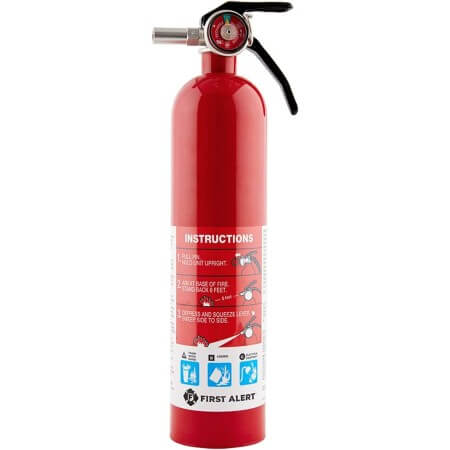
First Alert Standard Home Fire Extinguisher
Our Rating:

4.8
On a budget? No problem. We chose to feature the First Alert Standard Home Fire Extinguisher since it’s a cheap option for families on a limited budget. If you want to buy a few, it’s not outrageously costly at roughly $30 each. And, it’s just as effective as all the standard extinguishers out there.
The First Alert Standard Household Fire Extinguisher’s extinguishing agent is still rated to tackle most house fires, particularly cloth, wood, papers, flammable materials, and electrical fires, despite its reasonable cost. Even though it’s rechargeable, the expense of recharging outweighs the inexpensive cost of this extinguisher, thus buying a new one once you use it is definitely the better option.
It’s not as durable as the Amerex, but it’s lightweight and more compact due to tis aluminum body. A lighter extinguisher is a better option if you have small children or elderly family members who may be unable to move a bigger one during an emergency.
PROS
CONS
Features That Are Important In A Fire Extinguisher
Fire class
Choosing the correct kind of fire extinguisher is critical when making a purchase. For example, there are a few distinct types of flames dependent on the source of the fuel. Each fire extinguisher is assigned a rating based on the sorts of flames it can put out.
Your home or establishment’s safety may be improved if you know what each fire classification signifies. Knowing what sorts of fires to prepare for can help you choose the right extinguisher for you.
- Class A: Class A flames are combustibles that can be ignited without difficulty. These kinds of flames are fueled by materials that are usually flammable. Class A fires are often caused by materials such as wood, cloth, paper, rubbish, and plastic. This is the most prevalent kind of unintentional fire that occurs in a variety of different types of businesses. One example is a trash fire. For Class A fires, either mono ammonium phosphate or water is typically used to extinguish the flames.
- Class B: A fire classified as Class B is one that is fueled by a combustible liquid or gas. Petroleum-based lubricants and paint, paraffin, and gasoline are all common liquid fuels. Class B flames may also be fuelled by volatile chemicals like butane and propane. Industries working with fuel, oils, and certain kinds of paints are particularly vulnerable to Class B fires, which may spread quickly and cause significant damage. Chemical processes that have comparable effects to smothering these kinds of flames are also frequent solutions for removing oxygen from the air. Cooking fires are referred to as Class K fires and have their own categorization.
- Class C: In order to be classified as a Class C fire, a fire must employ electronic systems or electrified apparatus as its source. There are a number of things that may start an electrical fire. The usage of large electric operated equipment and/or the handling of flammable materials increases the risk of one. It is important to keep in mind that even little electrical fires might take place in any establishment (such as an overheated surge suppressor or poor cabling).
- Class D: It is a Class D fire if the origin of fuel is a flammable metal. Magnesium, Titanium, aluminum, and potassium are examples of these. Keep in mind that you may come across additional metals that have combustible qualities. There is a high risk of Class D fires in laboratory facilities.
- Class K: These fires are those caused by cooking incendiaries fueled by the combustible liquids employed in the cooking process. Even though Class K flames are technically a kind of liquid fire, they are unique enough to merit their own subtype. A broad variety of liquid cooking fuels are available for use in cooking fires. Class K flames often include oils, grease, and fat.
Size and Weight
Before purchasing a fire extinguisher from our top-rated selection, it is important to think about who will be using it in the event of a fire. Full-sized extinguishers may weigh as much as 20 pounds, but aerosol choices can weigh as little as a few ounces. Everyone in your household should be able to lift the canister with ease, regardless of their size.
Refills
Extinguishers that have been used or are about to expire may often be refilled. In many cases, refilling a canister is more cost-effective than purchasing a new one. Check with your local station to see whether this service is available.
Range
12 to 18 feet is the range of most fire extinguishers. Consider the potential spread of the flames in proportion to the size of your living area. More than one fire extinguisher is recommended for homes with a lot of square footage.
How We Chose the Best Home Fire Extinguisher
Quality
A team of fire extinguisher experts assessed materials, construction, ratings, and how the fire extinguisher brands meet industry standards, durability, and overall value. We tried out multiple brands to compare their performance head-to-head.
Reviews
We evaluated customer reviews, availability of customer support, company policies, and installation.
Brand
We gave priority to reputable fire extinguisher brands. We assessed how the company was rated by experts, customers, and third-party industry evaluators.
Frequently Asked Questions:
What is the best fire extinguisher for home use?
A three-in-one (A, B, and C) fire extinguisher is a good choice for the average family’s needs. However, take in mind the size of your house and the activities you engage in. A kitchen fire extinguisher may be a good investment if you cook often.
What is the best type of fire extinguisher?
There is no one-size-fits-all fire extinguisher. The best fire extinguisher will always depend on you, your location, and your conditions. For instance, if you run a business, you might need a more commercial fire extinguisher. If you work in a laboratory, it’s best to have a class d extinguishers.
What is the best fire extinguisher for a car?
Dry chemical and clean agent models work best for car fires. Dry chemical fire extinguishers work by interrupting chemical reactions of the fire and are effective against Class A, B, and C fires. Meanwhile, clean agent fire extinguishers use a mix of gases to put out Class A and B fires.
What type of fire extinguisher is used for most fires?
Most common fires are triggered by ordinary combustibles, flammable liquids and gases, and electrical equipment. Class ABC fire extinguishers can handle these common triggers of fires.
Where to buy a fire extinguisher
One of the best places to be fire extinguishers is on Amazon. It has been referred to as one of the most influential economic and cultural forces in the world, as well as the world’s most valuable brand. It offers a wide variety of fire extinguishers from different reputable brands, including Amerex, First Alert, and Kidde. Since it is an online platform, prices are better than brick-and-mortar local stores.

